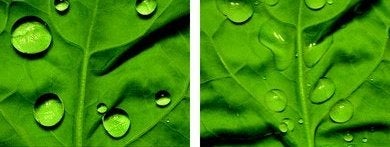Coffee Drinkers, Say Hello to Scald-Proof Nanofabric
Anyone who’s ever spilled a hot beverage in his or her lap will be happy to hear that chemists at...

Anyone who’s ever spilled a hot beverage in his or her lap will be happy to hear that chemists at the University of Minnesota have announced a scaldproof fabric.
Water-resistant fabric, of course, has already existed for some time — but its impermeability applies only to cool liquids. Hot coffee, scalding soup, and other liquids above a certain temperature, on the other hand, seep right through water-resistant cloth.
Why the difference? Water-repellant surfaces — whether natural, like a lotus leaf, or man-made, like a raincoat — work in two ways. A waxy hydrophobic coating inhibits water penetration, and a spiky texture traps air under water droplets, which limits the amount of contact the water will have with the surface. As a result, droplets remain near-spherical and roll off.
With scalding liquids, however, problems set in: not only do they cause the waxy coating to melt, but hot water also drives away the air. What’s more, hot water drops are able to make their way into smaller nooks in the surface. Classically water-resistant surfaces, like the leaves above, succumb to hot water, letting it ooze through without resistance.
Well aware of the above research and of recent studies pointing to the water-resilient properties of carbon nanotubes, the team of chemists at the University of Minnesota created a cocktail of carbon nanotubes, Teflon, and cotton fabric. This fabric successfully repels hot water, milk, coffee, and tea at 167 °F.
[via NewScientist.com]